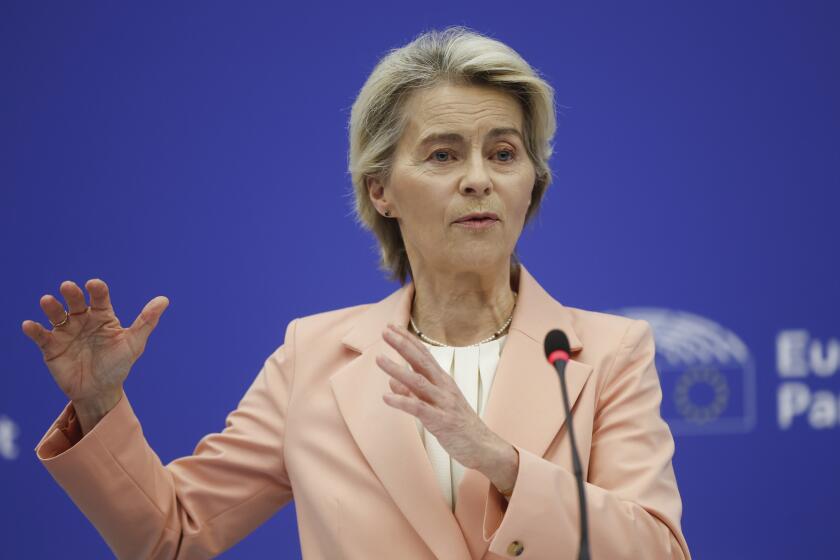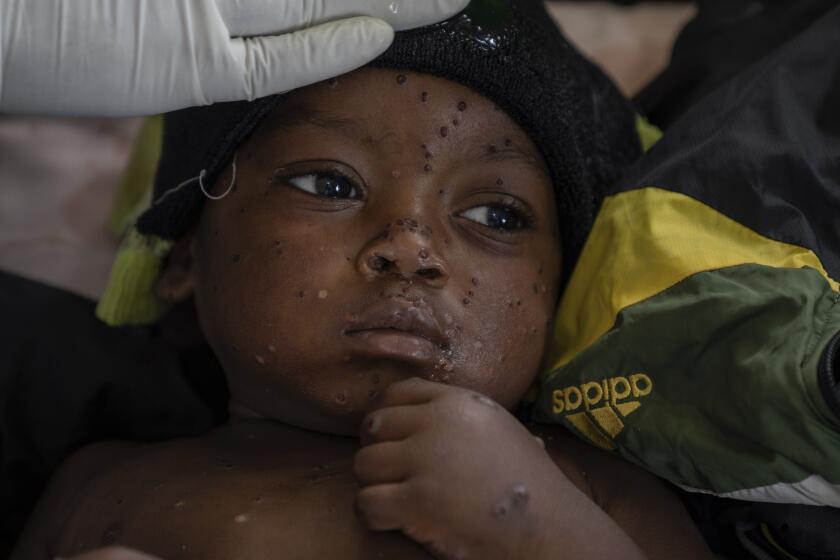U.S., France Draft Plan for Mideast Truce
The United States and France reached agreement Saturday on a draft resolution that calls for an end to the fighting in Lebanon and the eventual deployment of a U.N.-mandated peacekeeping force. But in the battle zone, the conflict intensified as Hezbollah unleashed a rocket barrage at northern Israel, killing three people, and heavy skirmishes erupted in the border region.
The draft U.N. resolution seeks “a full cessation of hostilities,” calling on Hezbollah to immediately stop all attacks and for Israel to cease “all offensive military operations.” The wording suggests that Israel would retain the right to act defensively, a term that could be interpreted broadly.
Although questions remain about many aspects of the draft, it represents the first real step by the international community to end 3 1/2 weeks of fighting -- in effect, starting a clock ticking toward a cease-fire.
The 15-member Security Council could take action on the resolution as early as today, but it appeared more likely that a vote would not come until Monday or Tuesday.
The draft resolution sets out a series of “principles” for Israel and Lebanon to follow, including the disarming of Hezbollah and the establishment of a buffer zone in southern Lebanon to prevent the militant group from firing rockets into Israeli territory.
After a special meeting Saturday afternoon of Security Council members, Lebanese Foreign Ministry official Nouhad Mahmoud criticized several aspects of the plan, including the absence of a requirement that Israel immediately withdraw its forces from his war-torn country. “That’s a recipe for more confrontation,” Mahmoud said.
Hezbollah, too, hinted that it would consider a cease-fire resolution only if it included an Israeli withdrawal.
“We will abide by it on condition that no Israeli soldier remains inside Lebanese land. If they stay, we will not abide by it,” Energy Minister Mohammed Fneish, a Hezbollah member, told reporters in Beirut before a Cabinet meeting Saturday.
In Jerusalem, the Israeli government refrained from official comment, but Cabinet minister Isaac Herzog called it a clear signal that the country faced time limits on its military offensive.
“We have the next few days to carry out many military actions,” he told Israel’s Channel One. “It is a fact that the time we have is getting shorter and shorter.”
U.S. Ambassador to the U.N. John R. Bolton characterized the draft as “workable” and said Security Council members offered “a lot of encouraging comments.” “We want this to be a transformational solution that moves the region beyond the problem that has existed for so many years,” he said.
French envoy Jean-Marc de la Sabliere said it was crucial to come up with a plan to prevent further violence. “Who could imagine that such a drama would happen again?” Sabliere said. “It would be irresponsible.”
Vitaly Churkin, the Russian ambassador, said, “Nobody is completely happy with a number of elements in this resolution.” But “if there is agreement between the two parties, we could support” the resolution, he said.
In Crawford, Texas, White House spokesman Tony Snow said Saturday that President Bush was “happy with [the draft] and he’s happy with the progress.” He declined to comment on what the administration thought of specific details.
The draft, which grew out of a proposal floated by France a week ago, was clearly aimed at diminishing the power of Hezbollah. It calls for a buffer zone in the south where the only armed forces would be the Lebanese army and the U.N. contingent. It also seeks an arms embargo to prevent Iran or Syria from supplying weapons to Hezbollah.
The wording in several parts of the draft seemed favorable to the U.S. position. The draft, for example, called for “the unconditional release” of abducted Israeli soldiers but only for “encouraging the efforts aimed at settling the issue of Lebanese prisoners detained in Israel.”
Israel was said to have accepted with great reluctance the temporary policing of south Lebanon by a beefed-up version of the existing U.N. force, which it regards as a failure.
After a vote on the resolution in the Security Council, a second resolution would be needed to authorize the deployment of an international force and spell out its mandate. The second resolution also would lay out a framework to finalize “a permanent cease-fire and a long-term solution” to the issues at the heart of the dispute.
In Beirut, a senior advisor to Lebanese Prime Minister Fouad Siniora said the government hoped to expand the draft’s wording to incorporate more provisions for a lasting cease-fire. “We may have to work on it to make it more consistent with the elements we believe are necessary to make the cease-fire a sustainable one,” Mohammed Shatah said in an interview.
Shatah said the Lebanese government was still hoping for U.N. endorsement of its proposals that Israel hand over disputed territory to the United Nations pending a final delineation of borders, mutual security provisions that would prevent future Israeli incursions and flights into Lebanese airspace, and “international security support” to allow the Lebanese military to regain control and sovereignty over southern Lebanon.
“We’re saying we want a cease-fire, but we also want a solution to all these problems,” Shatah said. “Maybe some provisions move it in that direction. But we want to work hard to make this a resolution at the Security Council that resolves all these issues. If we leave issues pending, if we don’t tackle issues that can be tackled, then we are leaving room for perhaps continuation of the conflict.”
Earlier in the day, Assistant U.S. Secretary of State David Welch met with Siniora and parliament Speaker Nabih Berri in an attempt to gauge reactions to a proposed solution. A Lebanese source familiar with the discussions said Welch proposed leaving contentious issues such as the disputed Shebaa Farms area held by Israel for later discussion by the Security Council.
But Berri told him, “If we leave it hanging, it’s a project for another war,” the source said. Berri also is said to have insisted that any cease-fire be accompanied by an Israeli withdrawal.
More heavy fighting broke out Saturday in Lebanese border villages, where Israeli troops have been trying to secure a 4-mile deep buffer zone. An estimated 10,000 Israeli soldiers have been battling Hezbollah fighters along a rugged 25-mile front.
Hezbollah reported Saturday that its fighters ambushed Israeli troops in Aita Shaab. Two Israeli soldiers died in the day’s clashes.
An Israeli barrage struck about a dozen towns along the border, with the heaviest directed at the town of Aitaroun, which Lebanese news reports said was hit by 2,000 shells. The Israeli military reported it carried out more airstrikes early today on roads in the eastern Bekaa Valley.
Lebanese emergency agencies said 11 people were killed and 75 injured Saturday, bringing the official confirmed death toll in the country to 686, most of them civilians. Siniora has said the actual figure is more than 900, with a large number of people still buried under rubble. The U.N. estimates that about 1 million people have been displaced.
Seventy-nine Israelis, including 46 soldiers and 33 civilians, have been killed, and tens of thousands have fled the north.
In what could be a prelude to either intense airstrikes or a widened ground offensive in southern Lebanon, the Israeli military called on people in the coastal city of Sidon to leave. It said it intended to attack Hezbollah rocket-launching sites.
The city normally has a population of about 100,000, but many people from the south have sought refuge there, some believing that because Sidon is primarily Sunni, it is not a major base for the Shiite Hezbollah.
Israeli military authorities said the target of an early morning raid Saturday in the Lebanese port of Tyre was a Hezbollah cell that had fired a long-range rocket that fell 50 miles inside Israel, near the city of Hadera, the southernmost strike to date.
In the Tyre raid, helicopter-borne Israeli naval commandos burst into an apartment building and engaged in a shootout with guerrillas inside. The military said eight Israeli soldiers were wounded and a “large number” of Hezbollah fighters were killed.
The army said the decision was made to send in special forces because an airstrike on the five-story apartment building probably would have caused civilian casualties.
By nightfall Saturday, Hezbollah guerrillas had fired almost 200 rockets into northern Israel, with nearly two-thirds of them falling over a 90-minute period in midafternoon.
A woman and her two daughters were killed when a rocket hit their home near the Bedouin village of Arab Aramshe, officials said. Dozens of people were hurt, and an 87-year-old woman taking cover in a bomb shelter suffered a heart attack soon after a strike in Kiryat Ata, near Haifa.
Hamilton reported from the United Nations and Murphy from Beirut. Times staff writers Laura King in Jerusalem, Nicole Gaouette in Crawford and Alissa J. Rubin in Grinnell, Iowa, contributed to this report.
More to Read
Sign up for Essential California
The most important California stories and recommendations in your inbox every morning.
You may occasionally receive promotional content from the Los Angeles Times.










